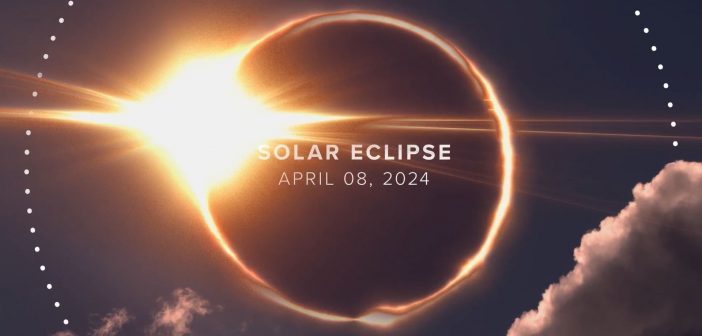Today, the Earth experiences a breathtaking astronomical phenomenon – a solar eclipse! As the Moon casts its shadow upon the Sun, a brief period of darkness descends, captivating skywatchers around the globe. While some regions witness a total eclipse where the Sun is entirely obscured, others experience a partial eclipse with a crescent-shaped Sun. This article delves into the details of the eclipse, including online viewing options for viewers in India, and explores the diverse religious and cultural observations surrounding this celestial event.
A Glimpse into the Eclipse: Timing and Visibility
This solar eclipse, occurring on April 8th, 2024, is a total eclipse, meaning the Moon completely blocks the Sun’s light in its path of totality. The centerline of this path stretches across parts of Mexico, the United States, and Canada. Unfortunately, India falls outside the direct path and won’t experience totality. However, depending on the location, a partial eclipse might be visible.
Observing the Eclipse from India
For those in India eager to witness this celestial event, fret not! Several online resources offer live streams of the eclipse. NASA, known for its exceptional coverage of astronomical phenomena, will likely be broadcasting the eclipse progress. You can search for “NASA 2024 Solar Eclipse Live Stream” to find their coverage. Additionally, reputable astronomy websites and platforms might also be hosting live streams. Remember to check the time difference between your location and the eclipse path to tune in at the appropriate time.
Sutak: A Hindu Observance During Eclipses
In Hinduism, eclipses hold significant religious importance. The period surrounding an eclipse is known as “Sutak,” a time of inauspiciousness. Pregnant women, elders, and those following strict religious practices often observe certain restrictions during Sutak. These may include avoiding cooking, eating, or engaging in religious rituals. It’s important to note that Sutak practices vary across regions and communities within Hinduism. Consulting with local religious authorities or elders can provide specific guidance on these observances.
Religious Beliefs and Eclipses Across Faiths
The awe-inspiring nature of eclipses has captured the imagination of various religions and cultures throughout history. Let’s explore some diverse beliefs and traditions associated with solar eclipses:
- Islam: Some Islamic traditions view eclipses as a sign from God, prompting prayers for forgiveness and well-being. Special eclipse prayers (Salat al-Khusuf) might be offered in mosques during this time.
- Christianity: Early Christian interpretations sometimes associated eclipses with divine judgment or omens. However, modern Christian denominations generally view them as natural phenomena.
- Judaism: Jewish tradition doesn’t hold specific rituals for eclipses. However, some people recite special prayers during eclipses.
- Buddhism: In Buddhism, eclipses are seen as natural occurrences. However, some believe they can influence karma or bring misfortune.
- Jainism: Jains revere non-violence and avoid activities that might harm living beings during eclipses, as sunlight is believed to sustain microscopic life.
- Sikhism: Sikhism doesn’t have specific rituals for eclipses. However, some Sikhs might visit Gurdwaras (Sikh places of worship) to offer prayers during this time.
Universal Wonder: A Shared Experience
While religious interpretations vary, the solar eclipse offers a universal spectacle that transcends cultural boundaries. Witnessing the Sun’s temporary disappearance is a humbling reminder of our place in the vast cosmos. Whether observed online or directly under the sky, this celestial event ignites curiosity and inspires wonder. So, step outside, tune into a live stream, or simply marvel at the beauty of the night sky tonight. The solar eclipse, a breathtaking display of astronomy, is a phenomenon to be cherished by all.
Additional Tips for Safe Eclipse Viewing
Looking directly at the Sun, even during a partial eclipse, can cause permanent eye damage. If you plan to observe the eclipse directly, use specially designed solar eclipse glasses with proper certification. Never look at the Sun through a telescope or binoculars without proper solar filters. Observing the eclipse online through live streams is the safest option.
Beyond the Spectacle: The Science Behind Solar Eclipses
The awe-inspiring darkness of a solar eclipse might seem like magic, but a fascinating interplay of celestial mechanics is at play. Here’s a deeper dive into the science behind this astronomical phenomenon:
Celestial Dance: The Mechanics of a Solar Eclipse
A solar eclipse occurs when the Moon comes between the Sun and Earth, casting a shadow on a part of our planet. For a total eclipse, the Moon’s shadow perfectly covers the Sun, creating a region of complete darkness for a brief period. The path of totality, where this complete darkness occurs, is a narrow band on Earth’s surface. For locations outside the path, a partial eclipse is visible, where the Sun appears crescent-shaped as the Moon covers only a portion of its surface.
Types of Solar Eclipses:
There are four main types of solar eclipses, each offering a unique celestial display:
- Total Eclipse: As mentioned earlier, this occurs when the Moon completely blocks the Sun’s light in the path of totality.
- Partial Eclipse: A partial eclipse is witnessed in regions where the Moon only covers a portion of the Sun, creating a crescent shape.
- Annular Eclipse: During an annular eclipse, the Moon’s apparent size is smaller than the Sun’s. The Moon casts a dark shadow on Earth, but a ring of sunlight remains visible around the Moon, forming a “ring of fire” effect.
- Hybrid Eclipse: This rare type of eclipse transitions between a total and annular eclipse during its path.
The Importance of Studying Eclipses:
Solar eclipses provide valuable insights for astronomers. The brief period of darkness allows scientists to study the Sun’s outer atmosphere, the corona, which is usually obscured by the Sun’s bright light. Additionally, eclipses help us understand the Moon’s orbital path and its precise alignment with the Sun and Earth.
Future Eclipses and Citizen Science:
The next total solar eclipse visible from the contiguous United States won’t occur until 2044. However, partial solar eclipses are more frequent. Information about upcoming eclipses and safe viewing guidelines can be found on websites of astronomy organizations like NASA or local astronomy clubs. Citizen science projects often involve collecting data on eclipses, such as observing the start and end times of totality. You can contribute to scientific research by participating in such projects.
Conclusion: A Journey of Discovery
The solar eclipse is a celestial phenomenon that ignites our curiosity about the universe. From the cultural and religious traditions surrounding it to the scientific understanding it offers, this astronomical event presents a multifaceted journey of discovery. So, the next time a solar eclipse graces our skies, take a moment to appreciate its beauty and the vast wonders it unveils about our place in the cosmos.






